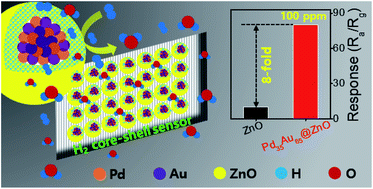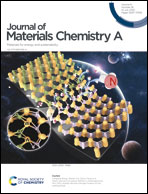Superfast and efficient hydrogen gas sensor using PdAualloy@ZnO core–shell nanoparticles†
Abstract
For ensuring the safety use of renewable hydrogen energy sources, it is urgently demanded to design rapid and sensitive sensors to detect leakage. In this study, we have successfully prepared highly responsive, stable, and selective sensors for hydrogen gas using PdAualloy@ZnO core–shell nanoparticles (CSNPs). The fabricated core–shell sensors exhibit superior hydrogen sensing activity as compared to pure ZnO. In particular, the Pd35Au65@ZnO sensor shows the highest response (80), fastest response/recovery times (0.6/12.0 min), and lowest optimal working temperature (300 °C) towards 100 ppm hydrogen. The improved hydrogen sensing can be attributed to the following: (1) the oxidation of Pd metal in the alloy cores is significantly limited, which in turn increases the interaction between Pd and the target gas; (2) the content of active oxygen species is enriched in the presence of the Au metal; (3) the PdAu alloy cores have excellent selective capability towards hydrogen gas as they produce PdHx compounds; and (4) the synergistic combination between Pd, Au, and ZnO parts can further speed the response and recovery times for the PdAualloy@ZnO core–shell sensors. This work provides a new approach for designing versatile hydrogen sensors using alloy@oxide core–shell nanostructures accordingly.



 Please wait while we load your content...
Please wait while we load your content...